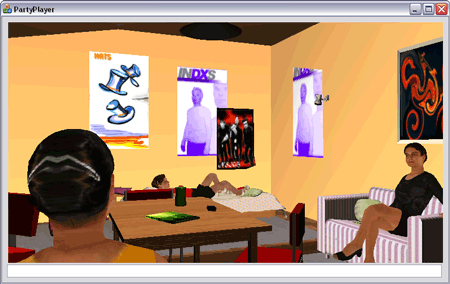|
|||||
Dramatic Gamingby Jarmo Laaksolahti In contrast to action games, the motivating factor for playing this game is not necessarily to win it, but to explore the social and emotional relations between characters. Action games have established themselves as the dominating genre in contemporary computer gaming. However, as gaming is taken up by new segments of the population (eg elderly people), other genres taking the interests of these segments into account need to be explored. Researchers at the Swedish Institute of Computer Science (SICS) are currently looking at interactive drama, where the focus is on experiencing a story rather than on action. According to Aristotelian dramatic principles, a drama consists of several parts or phases as depicted in Figure 1. The vertical axis represents time and the horizontal axis represents unresolved conflicts and unsettled emotions (complication). In the exposition phase, complication rises slowly as the viewer gets to know the characters and the situation. An inciting incident then adds momentum to the story leading to a quick rise of complication eventually building to a climax where the drama peaks. During the climax complications are resolved after which the level of complication rapidly drops.
The team at SICS are working on an interactive multi-character game prototype based on these dramatic principles. The scenario focuses on three teenage girls arranging a party for their friends and classmates. The basic idea is that the player takes on the role of one character, and interacts with the other computer-controlled non-player characters (NPCs) in the scenario. The task of the player is to arrange an invitation list for the party together with the NPCs. The game is realised as a simulated dialogue between the player and the NPCs in the game. Players interact with the NPCs by typing sentences on the keyboard. NPCs in turn make use of gaze, facial expression, gesture and body posture as well as synthesised speech in a synchronised fashion to express themselves. The game is turn-based, in that during each turn either the player or an NPC is able to say something. NPCs are equipped with a model of social relations based on sociological theory that partly determines their behaviour in the world. At any given moment an NPC's relation towards another NPC or the player can range from 'very positive' to 'very negative'. Depending on how the player acts or reacts, relations will change and events will unfold in different ways. Dramatic principles manifest themselves in the game since the game keeps track of the level of complication and attempts to turn events in a direction that roughly fulfils a dramatic arc. As the 'story' of the game is intended to be one of changing friendships between the characters, we decided to use the social model to also model complication. Thus the game aims to manage the development of social relationships over the course of the gaming session. At the beginning of the game, relationships between characters are somewhere on the positive side of the scale. As the game progresses the game will attempt to push events in a direction that makes the social relationships first become negative (increasing complication) and then either return to neutral/positive or remain in the negative range as the game ends, thus reflecting a more permanently changed relation.
In order to choose between different courses of action, the game evaluates the dramatic consequences of each turn before it is executed. If it is detected that a turn may have dramatically undesirable effects, eg the dramatic arc becomes too distorted, the turn instead passes to another character. The procedure is repeated until a dramatically pleasing turn is found, or if none exists, until all characters have been tried. In the latter case the least undesirable turn is chosen for execution. Compared to traditional planning techniques such as searching for ways to combine scenes into desirable plot paths, anticipation as described here is a more passive way of planning. Instead of actively searching for the best path the main concern for our anticipatory system is to detect and avoid undesirable states. In contrast to action games, the motivating factor here is not necessarily to win the game, but instead to explore the social and emotional relationships between characters. Thus instead of monster-bashing, the goal of the game is to navigate a socio-emotional web and find a path through it. This requires both sensitivity and attentiveness to social and emotional cues from players. Seen in this light, the task of compiling the invitation list for the party becomes more of a pseudo-task than the real task of the game. Link: Please contact: |
|||||




